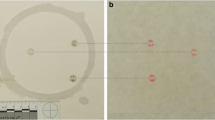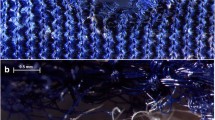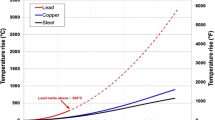Abstract
This study examines the potential formation of land and groove rifling characteristics in bullet wipe residue deposited on textile fabrics. Textile fabrics comprised of natural, synthetic, semi-synthetic, and blended fibers were damaged either individually or as triplicate layers using two different ammunition types: Winchester WinClean 115 grain 9 mm Luger BEB and Speer 115 grain 9 mm Luger TMJ. Each ammunition type was fired in triplicate using a 9 mm Luger caliber Glock 17 at a distance of approximately 6 feet at normal incidence to the target. The bullet hole was first observed under a stereomicroscope, photographed under tungsten and infrared illumination to observe chemical residues, and subsequently tested for the presence of copper and lead residues. The preliminary chemical results show that land and groove rifling class characteristics can form in bullet wipe residue deposited on textile fabrics. The composition of the fabric, cleanliness of the interior surface of the firearm barrel, presence of intervening layers of fabric, and the bullet type are all potential contributing factors to the detection of rifling characteristics.






Similar content being viewed by others
References
Carr D, Kieser J, Mabbott A, Mott C, Champion S, Girvan E (2014) Damage to apparel layers and underlying tissue due to hand-gun bullets. Int J Legal Med 128(1):83–93
Dalby O, Butler D, Birkett JW (2010) Analysis of gunshot residue and associated materials—a review. J Forensic Sci 55(4):924–943
Haag LC (1989) A microchemical test for copper-containing bullet wiping. AFTE 21(2):298–303
Rijnders M, Stamouli A, Bolck A (2010) Comparison of GSR composition occurring at different location around the firing position. J Forensic Sci 55(3):616–623
Haberda A, Eduard R (1919) Hoffmanns lehrbusch der gerichlichen medizin. Urban & Schwarzenberg, Berlin, pp 326–357
Heard BJ (2008) Firearms and ballistics: examining and interpreting forensic evidence. Wiley-Blackwell, Chichester
Dockery CR, Rosenberg MB, Kammerdiener K, McAdams LE, Brutto NA, Turner J et al (2011) The occurrence of false positive tests for gunshot residue based on simulations of the suspect’s occupation. J Undergrad Chem Res 10(3):107–110
Strassmann F (1885) Lehrbuch der gerichtlichen medicin. Enke, Stuttgart, pp 376–385
Zeichner A (2003) Recent developments in methods of chemical analysis in investigation of firearm-related events. Anal Bioannal Chem 376:1178–1191
Haag LC (2001) The sources of lead in gunshot residue. AFTE 33(3):212–218
Kemp SE, Carr DJ, Kieser J, Niven BE, Taylor MC (2009) Forensic evidence in apparel fabrics due to stab events. Forensic Sci Int 191(1–3):86–96
Houck M, Siegel J (2010) Fundamentals of forensic science, 2nd edn. Elsevier, Boston
Bailey J (2005) Analysis of bullet wipe patterns on cloth targets. J Forensic Identification 55(4):448–461
Krishnan SS (1974) Firing distance determination by atomic absorption spectrophotometry. J Forensic Sci 19:351–356
Bergman P, Agron N, Springer E (1987) Estimation of a bullet diameter using the bullet hole identification kit (BTK). J Forensic Sci 32(4):866–879
Weiss R, Giverts P, Bokobza L, Volkov N, Vinokurov A (2016) Determination of bullet type, sequence of firing, and time between discharges by examination of bullet wipe residues. AFTE 48(1):38–42
Thompson E, Haag LC (2009) Comet tail/vortex effect. AFTE 41(3):257–267
Author information
Authors and Affiliations
Corresponding author
Additional information
Publisher’s note
Springer Nature remains neutral with regard to jurisdictional claims in published maps and institutional affiliations.
Rights and permissions
About this article
Cite this article
Roberts, K.A., Fischer, G. & Davis, A.R. Identification of polygonal barrel rifling characteristics in bullet wipe residue deposited on textiles. Int J Legal Med 134, 533–542 (2020). https://doi.org/10.1007/s00414-019-02009-0
Received:
Accepted:
Published:
Issue Date:
DOI: https://doi.org/10.1007/s00414-019-02009-0




